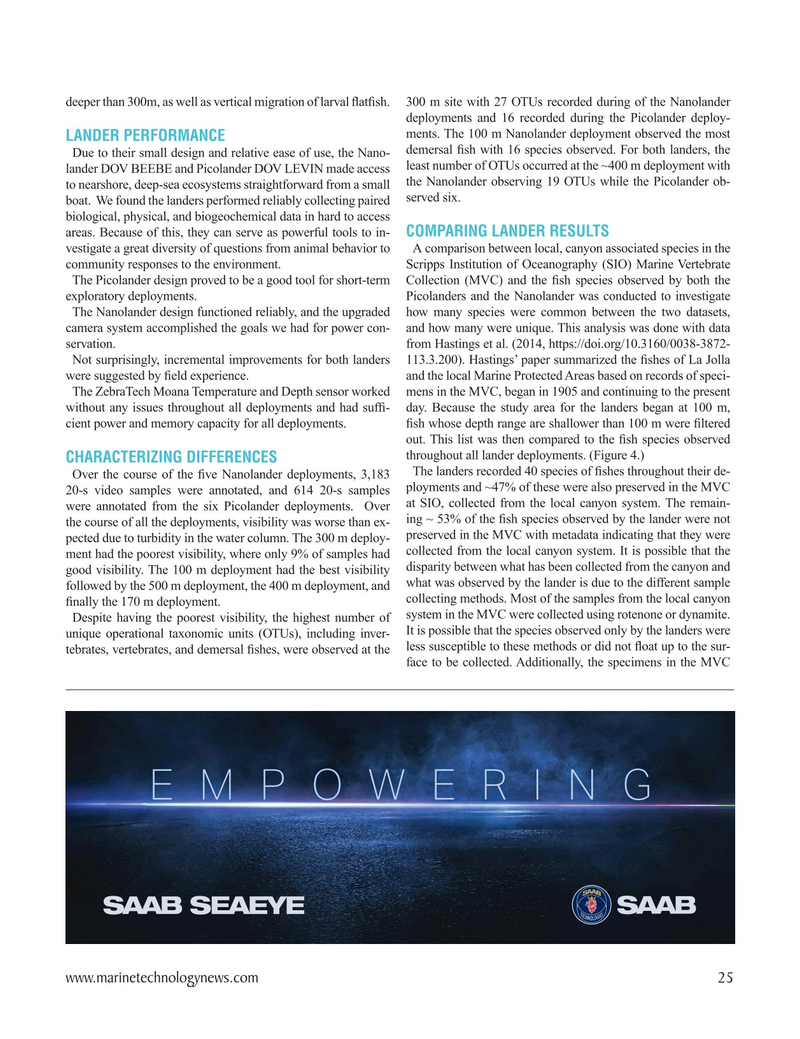
Page 25: of Marine Technology Magazine (March 2022)
Read this page in Pdf, Flash or Html5 edition of March 2022 Marine Technology Magazine
deeper than 300m, as well as vertical migration of larval ? at? sh. 300 m site with 27 OTUs recorded during of the Nanolander deployments and 16 recorded during the Picolander deploy- ments. The 100 m Nanolander deployment observed the most
LANDER PERFORMANCE demersal ? sh with 16 species observed. For both landers, the
Due to their small design and relative ease of use, the Nano- least number of OTUs occurred at the ~400 m deployment with lander DOV BEEBE and Picolander DOV LEVIN made access the Nanolander observing 19 OTUs while the Picolander ob- to nearshore, deep-sea ecosystems straightforward from a small served six. boat. We found the landers performed reliably collecting paired biological, physical, and biogeochemical data in hard to access areas. Because of this, they can serve as powerful tools to in-
COMPARING LANDER RESULTS vestigate a great diversity of questions from animal behavior to A comparison between local, canyon associated species in the community responses to the environment. Scripps Institution of Oceanography (SIO) Marine Vertebrate
The Picolander design proved to be a good tool for short-term Collection (MVC) and the ? sh species observed by both the exploratory deployments. Picolanders and the Nanolander was conducted to investigate
The Nanolander design functioned reliably, and the upgraded how many species were common between the two datasets, camera system accomplished the goals we had for power con- and how many were unique. This analysis was done with data servation. from Hastings et al. (2014, https://doi.org/10.3160/0038-3872-
Not surprisingly, incremental improvements for both landers 113.3.200). Hastings’ paper summarized the ? shes of La Jolla were suggested by ? eld experience. and the local Marine Protected Areas based on records of speci-
The ZebraTech Moana Temperature and Depth sensor worked mens in the MVC, began in 1905 and continuing to the present without any issues throughout all deployments and had suf? - day. Because the study area for the landers began at 100 m, cient power and memory capacity for all deployments. ? sh whose depth range are shallower than 100 m were ? ltered out. This list was then compared to the ? sh species observed throughout all lander deployments. (Figure 4.)
CHARACTERIZING DIFFERENCES
The landers recorded 40 species of ? shes throughout their de-
Over the course of the ? ve Nanolander deployments, 3,183 20-s video samples were annotated, and 614 20-s samples ployments and ~47% of these were also preserved in the MVC were annotated from the six Picolander deployments. Over at SIO, collected from the local canyon system. The remain- ing ~ 53% of the ? sh species observed by the lander were not the course of all the deployments, visibility was worse than ex- preserved in the MVC with metadata indicating that they were pected due to turbidity in the water column. The 300 m deploy- ment had the poorest visibility, where only 9% of samples had collected from the local canyon system. It is possible that the good visibility. The 100 m deployment had the best visibility disparity between what has been collected from the canyon and what was observed by the lander is due to the different sample followed by the 500 m deployment, the 400 m deployment, and collecting methods. Most of the samples from the local canyon ? nally the 170 m deployment.
Despite having the poorest visibility, the highest number of system in the MVC were collected using rotenone or dynamite.
It is possible that the species observed only by the landers were unique operational taxonomic units (OTUs), including inver- tebrates, vertebrates, and demersal ? shes, were observed at the less susceptible to these methods or did not ? oat up to the sur- face to be collected. Additionally, the specimens in the MVC
EMPOWERING www.marinetechnologynews.com 25
MTR #3 (18-33).indd 25 2/25/2022 4:03:27 PM

 24
24

 26
26
